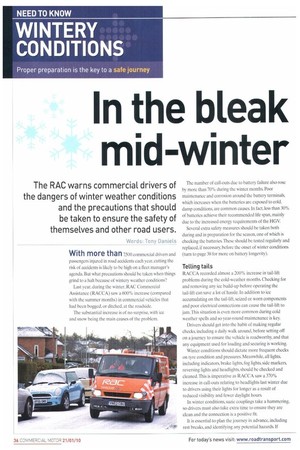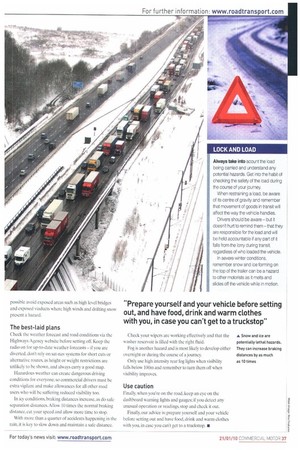In the bleak mid winter
Page 36

Page 37

If you've noticed an error in this article please click here to report it so we can fix it.
The RAC warns commercial drivers of the dangers of winter weather conditions and the precautions that should be taken to ensure the safety of themselves and other road users.
Words: Tony Daniels
With more than 7500 commercial drivers and passengers injured in road accidents each year, cutting the risk of accidents is likely to be high on a fleet manager's agenda. But what precautions should be taken when things grind to a halt because of wintery weather conditions?
Last year, during the winter, RAC Commercial Assistance (RACCA) saw a 600% increase (compared with the summer months) in commercial vehicles that had been bogged, or ditched, at the roadside.
The substantial increase is of no surprise, with ice and snow being the main causes of the problem. The number of call-outs due to battery failure also rose by more than 70% during the winter months. Poor maintenance and corrosion around the battery terminals, which increases when the batteries are exposed to cold, damp conditions, are common causes. In fact, less than 30% of batteries achieve their recommended life span, mainly due to the increased energy requirements of the HGV.
Several extra safety measures should be taken both during and in preparation for the season, one of which is checking the batteries These should be tested regularly and replaced, if necessary, before the onset of winter conditions (turn to page 38 for more on battery longevity).
Telling tails
RACCA recorded almost a 200% increase in tail-lift problems during the cold-weather months Checking for and removing any ice build-up before operating the tail-lift can save a lot of hassle. In addition to ice accumulating on the tail-lift, seized or worn components and poor electrical connections can cause the tail-lift to jam. This situation is even more common during cold weather spells and so year-round maintenance is key.
Drivers should get into the habit of making regular checks, including a daily walk around, before setting off on a journey to ensure the vehicle is roadworthy, and that any equipment used for loading and securing is working.
Winter conditions should dictate more frequent checks on tyre condition and pressures. Meanwhile, all lights, including indicators, brake lights, fog lights, side markers, reversing lights and headlights, should be checked and cleaned. This is imperative as RACCA saw a 370% increase in call-outs relating to headlights last winter due to drivers using their lights for longer as a result of reduced visibility and fewer daylight hours.
In winter conditions, suzie couplings take a hammering, so drivers must also take extra time to ensure they are clean and the connection is a positive fit.
It is essential to plan the journey in advance, including rest breaks, and identiftiing any potential hatards. If
possible avoid exposed areas such as high level bridges and exposed viaducts where high winds and drifting snow present a hazard.
The best-laid plans
Check the weather forecast and road conditions via the Highways Agency website before setting off. Keep the radio on for up-to-date weather forecasts — if you are diverted, don't rely on sat-nay systems for short cuts or alternative routes, as height or weight restrictions are unlikely to be shown, and always carry a good map.
Hazardous weather can create dangerous driving conditions for everyone, so commercial drivers must be extra vigilant and make allowances for all other road users who will be suffering reduced visibility too.
In icy conditions, braking distances increase, as do safe separation distances. Allow 10 times the normal braking distance, cut your speed and allow more time to stop.
With more than a quarter of accidents happening in the rain, it is key to slow down and maintain a safe distance. Check your wipers are working effectively and that the washer reservoir is filled with the right fluid.
Fog is another hazard and is most likely to develop either overnight or during the course of a journey.
Only use high intensity rear fog lights when visibility falls below 100m and remember to turn them off when visibility improves.
Use caution
Finally when you're on the road, keep an eye on the dashboard warning lights and gauges; if you detect any unusual operation or readings, stop and check it out.
Finally, our advice is: prepare yourself and your vehicle before setting out and have food, drink and warm clothes with you, in case you can't get to a truckstop. •




































































































































